The 8 Weeks Leg Workouts for Mass and Definition plan can help you move toward your goals.
Use this workouts program for muscle mass and define leg, it targets your entire lower body muscles such as quads and hamstrings to tire the muscles in your legs so you can get bigger and better.
Not only will you build your leg, but some of these lower body lift compounds recruit multiple muscles at once – which in turn leads to a greater hormone response, causing the body to release more anabolic hormones such as testosterone and growth hormone.
This article examines the best “leg workouts” for building bigger legs that when you combine with healthy eating, a solid fitness plan, based on mass and definition, workouts specific to your legs.
Leg anatomy information
1. Quadriceps
The quadriceps femoris, located on the front of the thigh, has four distinct heads and these muscles group allow your knees to straighten from a bent position:
- Rectus Femoris:
- This femoris arises from the front of the pelvic bone.
- Vastus Medialis:
- This arises from the inner edge of the femur.
- Vastus Lateralis:
- It arises from the outer edge of the femur.
- Vastus Intermedius:
- It arises from the front surface of the femur and lies beneath the rectus femoris.
These four heads merge together, are joined by the patella (knee cap), and then insert through a single (patellar) tendon onto the tibia just below the knee joint. The main function of your quadriceps is to extend your knee and straighten the leg. Because the rectus femoris originates from the pelvic bone, contraction of this muscle also flexes your hip joint.
Good workouts to target Quadriceps muscles
- Barbell squat
- Hack squat
- Leg extension
- Lunge
- Leg press
2. Hamstrings
The hamstrings, located at the back of the thigh, are a group of three muscles that originate from the ischium bone of the pelvis.
- Biceps Femoris:
- It attaches to the head of the fibula bone just below the knee through the back of the outer thigh.
- Semimembranosus:
- It passes behind the inner aspect of the thigh, attaches to the bone of the upper tibia behind the knee.
- Semitendinosus:
- It passes behind the inner aspect of the thigh, attaches to the bone of the upper tibia adjacent to the semimembranosus.
All these three hamstrings are stretched in both the knee and hip joints. Therefore, they serve a dual function:
- Knee flexion
- Extension of the hip
Good workouts to target Hamstrings muscles
- Stiff-leg deadlift
- Lying leg curl
- Standing leg curl
3. Gluteus
The gluteus maximus arises from a large area behind the pelvic bone, passes behind the hip joint, and attaches to the upper femur. This powerful muscle causes hip expansion.
Other thigh muscles induce the following:
- Hip adductor (inner thigh):
- Gracilis; adductor longus, magnus, and brevis
- Hip abductors:
- Tensor fascia lata; gluteus medius and minimus
- Hip flexors:
- Sartorius, iliopsoas, rectus femoris
Good workouts to target Gluteal muscles
- Squat
- Deadlift
- Lunge
4. Calves
There are 10 different muscles in the lower leg where your calf comprises two muscles:
- The gastrocnemius is the visible muscle of your calf. The two heads of the gastrocnemius (medial and lateral) arise from behind the femur bone, just above the knee joint.
- The soleus originates from the rear aspect of the tibia and is located underneath the gastrocnemius.
The tendons of the gastrocnemius and soleus fuse to form the Achilles tendon which passes behind your ankle joint and attaches to your calcaneus (heel bone). Your calf muscles cause plantar flexion of your ankle. Movement required to stand on tiptoe. The relative contribution of your two calf muscles depends on the angle of flexion of the knee. The gastrocnemius is the prime mover when your leg is straight and the sole becomes more active as the knee is bent. Note that your gastrocnemius crosses both the knee and ankle joints. And so it serves a dual function:
- Knee flexion
- Ankle flexion
The following are other lower leg muscles:
- Ankle extension (dorsiflexion):
- Tibialis anterior
- Ankle eversion:
- Peroneus longus and brevis
- Ankle inversion:
- Tibialis posterior
- Toe flexors and extensors:
- Flexor diligatorum longus
- Flexor hallucis longus
- Extensor digitorum longus
- Extensor hallucis longus
Good workouts to target Calves muscles
- Standing calf raise
- Seated calf raise
- Machine calf raise
- Donkey calf raise
Leg Workouts Schedule for Mass and Definition
| Days | Workouts |
|---|---|
| Wednesday: | Leg workouts for mass |
| Saturday: | Leg workouts for definition |
The 8 weeks leg workouts training regimen is divided into two days in a week. This plan is tailored to suit your current muscle gain or fat loss workout program; Schedule your regular training and cardio routine and swap your normal leg workouts for these tasks two days a week, with resting two days between the muscles being trained.
1. Wednesday: Leg Workouts for Mass
| Workouts | Sets x Reps |
|---|---|
| Body weight squat | 2 x 25 |
| Barbell squat | 5 x (6-8) |
| Barbell rack deadlift | 5 x (6-8) |
| Standing calf raise | 5 x (6-8) |
Note: Rest 2-3 minutes after every workouts set.
1. How To Do Bodyweight Squat?
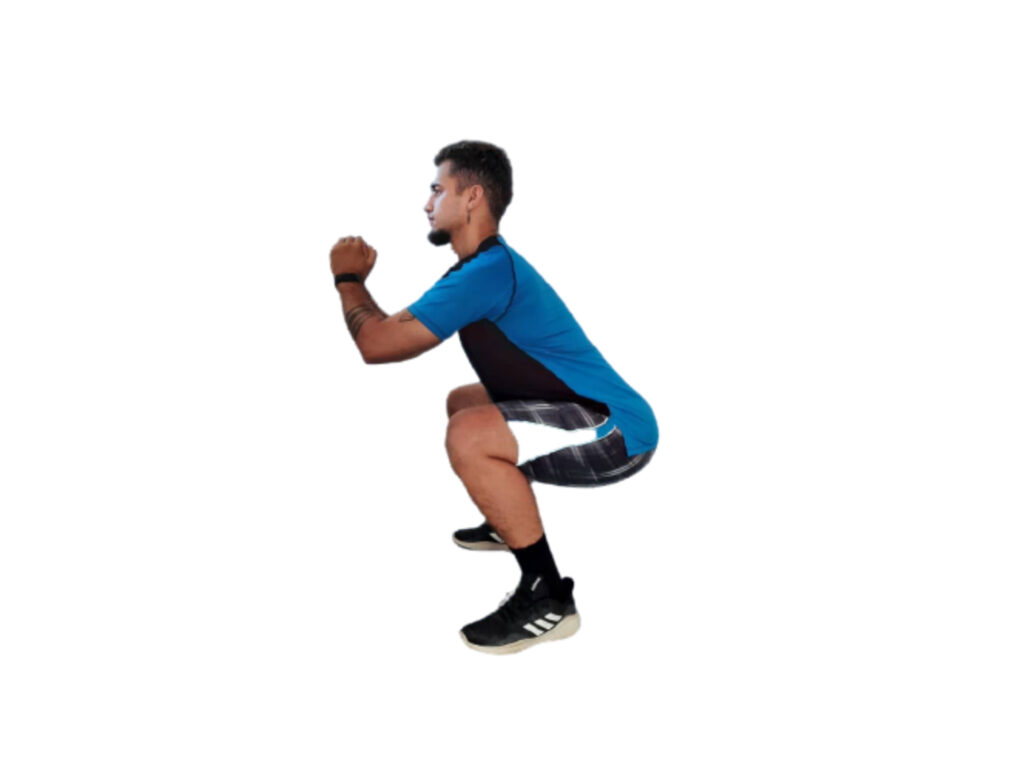
Bodyweight squat, also known as air squats, is commonly used in training programs such as CrossFit and leg workouts routines. This is done using only the own bodyweight, whereas regular squats can use extra weight instead. You should feel the squat in the thighs and glutes.
Bodyweight squat is a great way to learn proper form for squats. Once you’ve done them, you can move on to weighted squats safely and with very little risk of injury.
It also helps to build both a solid strength foundation and balance in the lower body. This means stretching and warming up first. Even if you’re only doing squats, it’s essential. The exercise specifically targets the thighs, hamstrings, quadriceps and glutes, helping add muscle to these areas. Because balance is essential, the bodyweight squat can also engage the core.
Instructions:
- Stand with your feet shoulder-width apart and point straight ahead.
- While squatting, the hips will move down and back.
- The lumbar curve should be maintained, and the heels should remain flat on the floor the entire time.
- In bodyweight squat, the hips will drop below the knees.
Pro Tip:
- The knees should not go past the toes.
- The back should not be round.
- You should not drop the shoulders forward. The lower body should be the only part of you moving.
- Keep the eyes on the wall in front of you. This will keep the chest raised.
2. How To Do Barbell Squat?
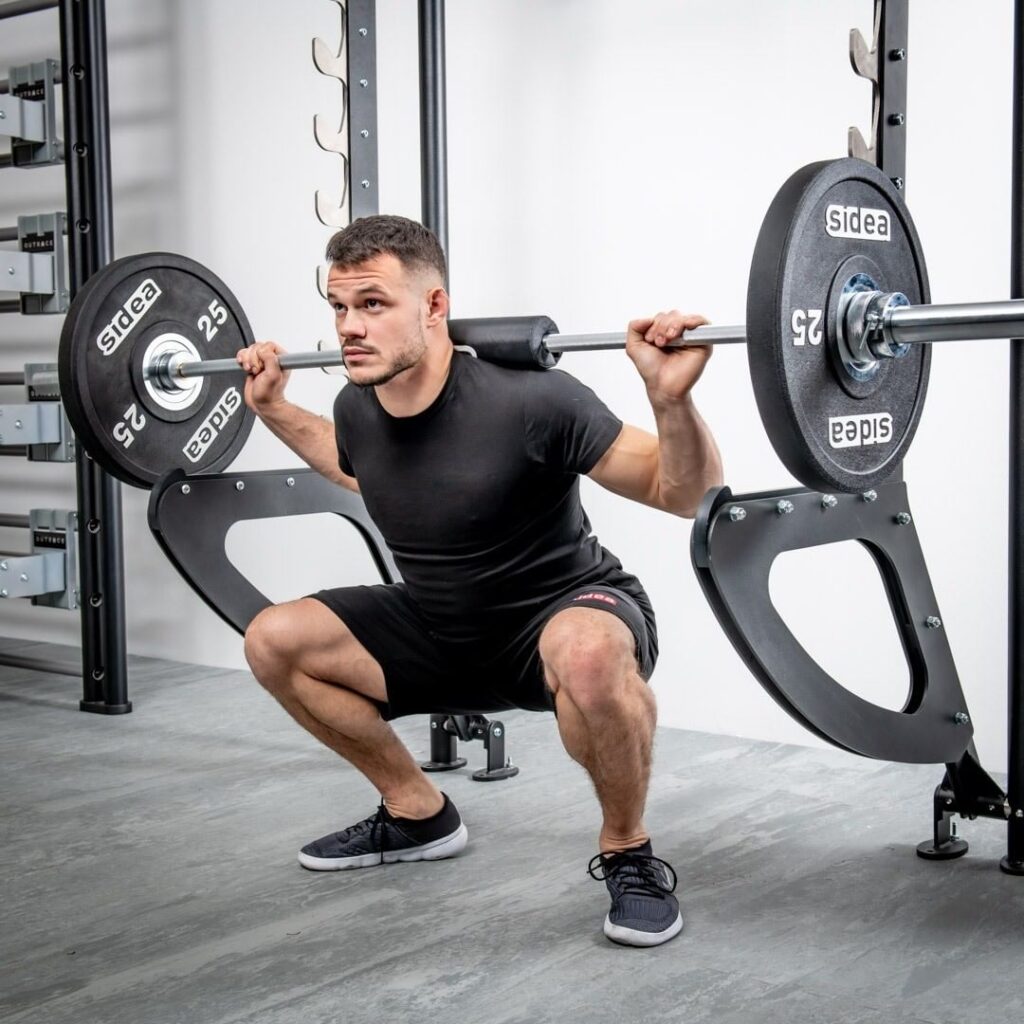
The Barbell Squat is a popular compound movement that emphasizes the muscle groups of the lower body and building overall strength. It’s the classic way to start a leg workouts, and a worthy centerpiece for a lower-body training program.
It adds size and strength to your quads, glutes and hamstrings. The barbell squat is considered by many to be the “king of exercise”.
It has sometimes come under criticism for being hard on the back and knees, but when performed correctly, it is basically one of the best exercises for strength, muscle mass, sports performance and long-term health.
Instructions:
- Set a bar in a rack just below shoulder height and load up on weight plates (if you’re new to squatting, start small weight to get a feel for the exercises, mechanics and your current abilities).
- Grab the bar with your hands just outside your shoulder-width apart, step down and rest the barbell on your back.
- Pushing up with your legs, lift the bar off the rack and take a step back from the rack. Stand with your feet shoulder-width apart, bend at the knees slightly, pull in the lower abs, and keep the head in line with the spine, keeping eyes forward.
- Begin the squat by bending at the knees and hips to lower the body once it is correctly positioned. Keep the ankles flat on the floor.
- Push yourself firmly back to the starting position, reflecting the descent.
Pro Tip:
- Make sure the bar is centered on your back for even distribution of weight.
- Keep the back as straight as possible throughout the lift to avoid strain or injury.
3. How To Do Barbell Rack Deadlift?
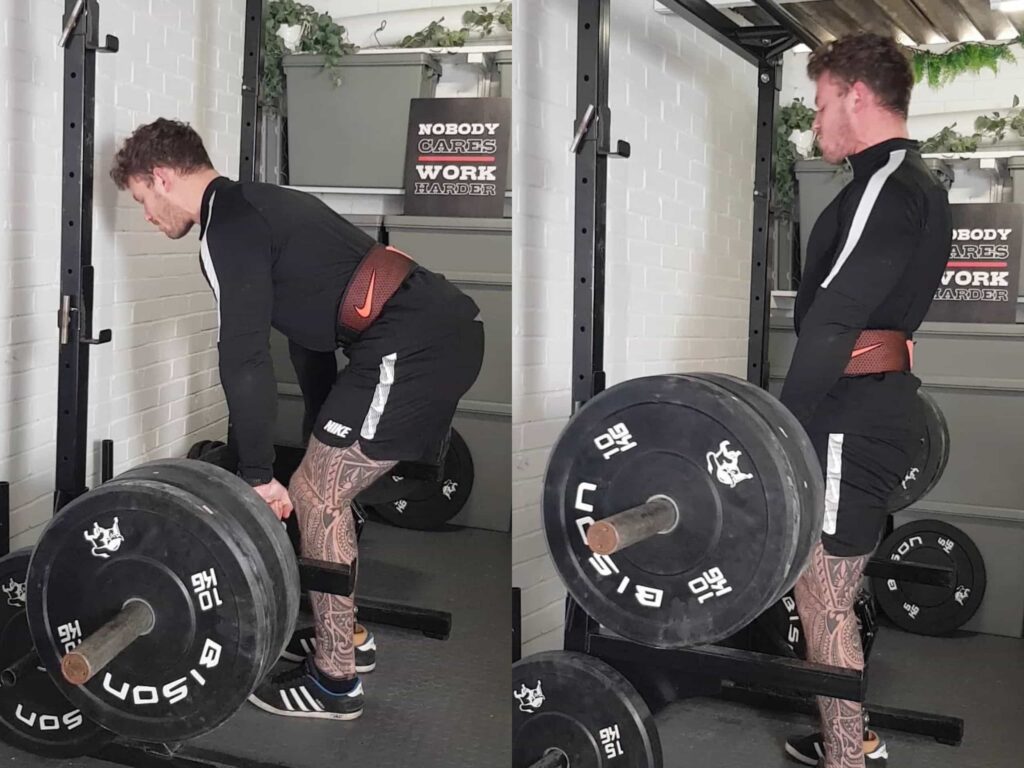
The barbell rack deadlift, also known as the rack pull, targets your lower back and leg muscles such as the glutes and hamstrings, and you’ll also increase the strength of your grip.
The barbell rack deadlift is a variation of the deadlift, not working as many different muscles and joints as the deadlift, so if you’re looking to improve your deadlift or focus on elevating your leg and back muscles, then add the Barbell Rack Deadlift exercise to your workouts routine.
The Barbell Rack Deadlift and Deadlift are both hip-hinge movements, which activate the glutes and spinal erectors.
When performing a partial range of motion, the goal is to prioritize the load over the range of motion. Therefore, the goal of this exercise is to use a higher weight than you would otherwise be able to do from the floor.
The barbell rack deadlift has a shorter range of motion than the deadlift, it works the same muscles and by shortening the speed of the exercise, it allows you to lift heavier weights. This will strengthen the back muscles, as well as help improve your form and power in the top part of the standard deadlift.
Instructions:
- Go to the squat rack. Before you start the exercise, you need to determine the height of your rack. This will be different for everyone based on your personal height. Most people prefer to place the rack just below the knee or just above the knee.
- Place barbell on rack and add weight. Aim for the same weight that you use for a regular deadlift. If you’re unsure, start with a low weight and gradually add more weight as needed.
- Get in position. Reach the bar so that your toes are just below it, pointing straight ahead. Your feet should be shoulder width apart. Your back should be arched. Point your gaze straight ahead.
- Bend the knees slightly so that your hands wrap around the bar. You can position your hands such that they hold the bar over the top or blend in. Your hands should be just outside the knees.
- Once you have a comfortable grip, inhale and start lifting the bar. As you lift, extend through hips and knees. You will be pulling the weight up and back, pulling your shoulders back until you achieve lockout.
- Keep the weight on top.
- Return the bar to the rack by bending the knees and lowering the upper body. Keep your back straight and keep looking forward. Exhale and come out of the position.
4. How To Do Standing Calf Raise?
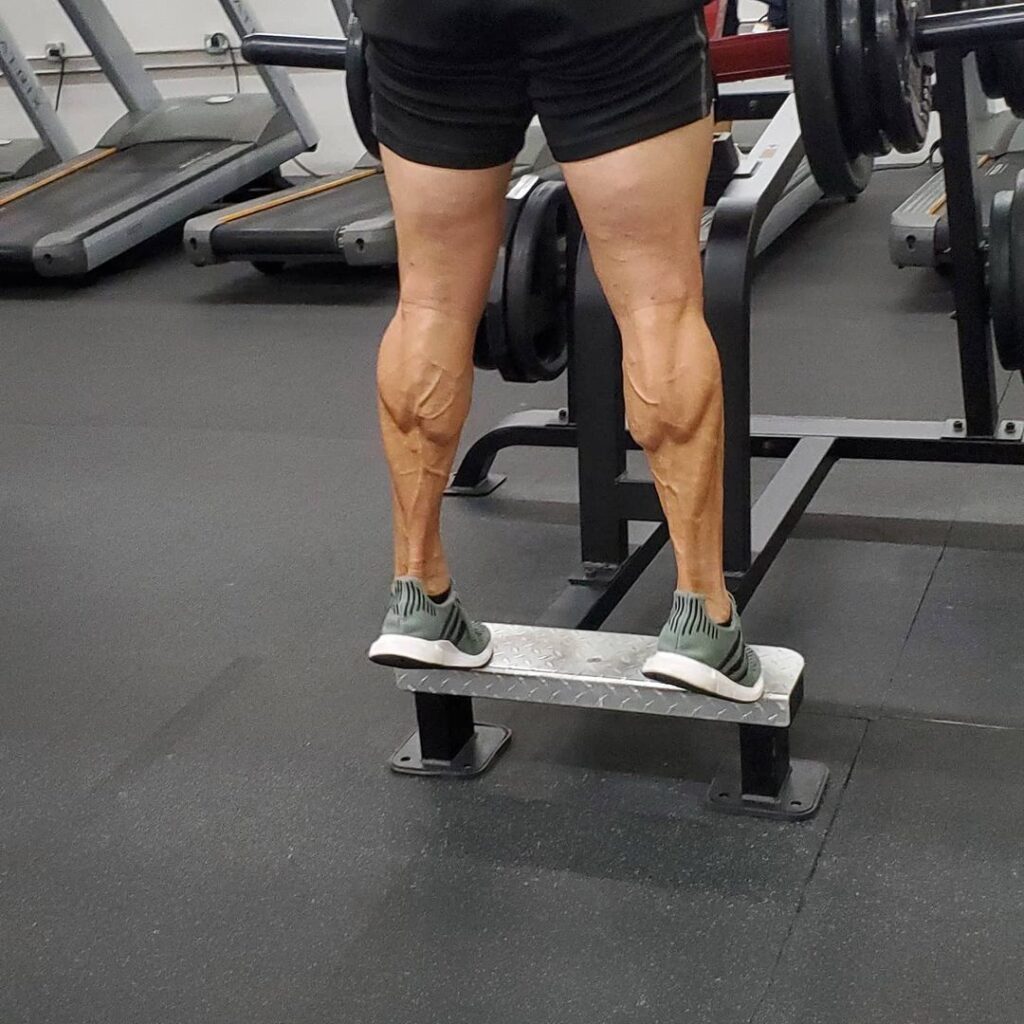
Standing calf raises target the calf muscles – specifically the gastrocnemius (heaviest part of the muscle) and soleus (the lower part of the muscle).
Working out these muscles is not just for bodybuilders and athletes. Incorporate Standing Calf Raise exercises into your leg workouts routine. Because these muscles are not only important for improving the sculpted, symmetrical form of your legs, they also help you maintain balance and stability, especially as you age.
Instructions:
- Adjust the shoulder pads so that the knees should be bent to position themselves under the pads (about six inches of relaxation is desired). Once in pad bottom position, place the balls of the feet on the foot plate, with the heels hanging down from the edge.
- Inhale, press with feet (plantar flexion) until calves are fully flexed, legs straight at knees and abdominals tense, and exhale in full (positive) motion.
- Breathe in in full (negative) motion until the heels are just below the plate of the feet (a deep stretch will be felt in the calves).
2. Saturday: Leg Workouts for Definition
| Workouts | Sets x Reps |
|---|---|
| Bodyweight squat | 2 x 25 |
| Dumbbell front squat | (3-4) x (12-15) |
| Dumbbell split squat | (3-4) x (12-15) |
| Barbell hip thrust | (3-4) x (12-15) |
Note: Rest 1-2 minutes after every workouts set.
1. How To Do Dumbbell Front Squat?
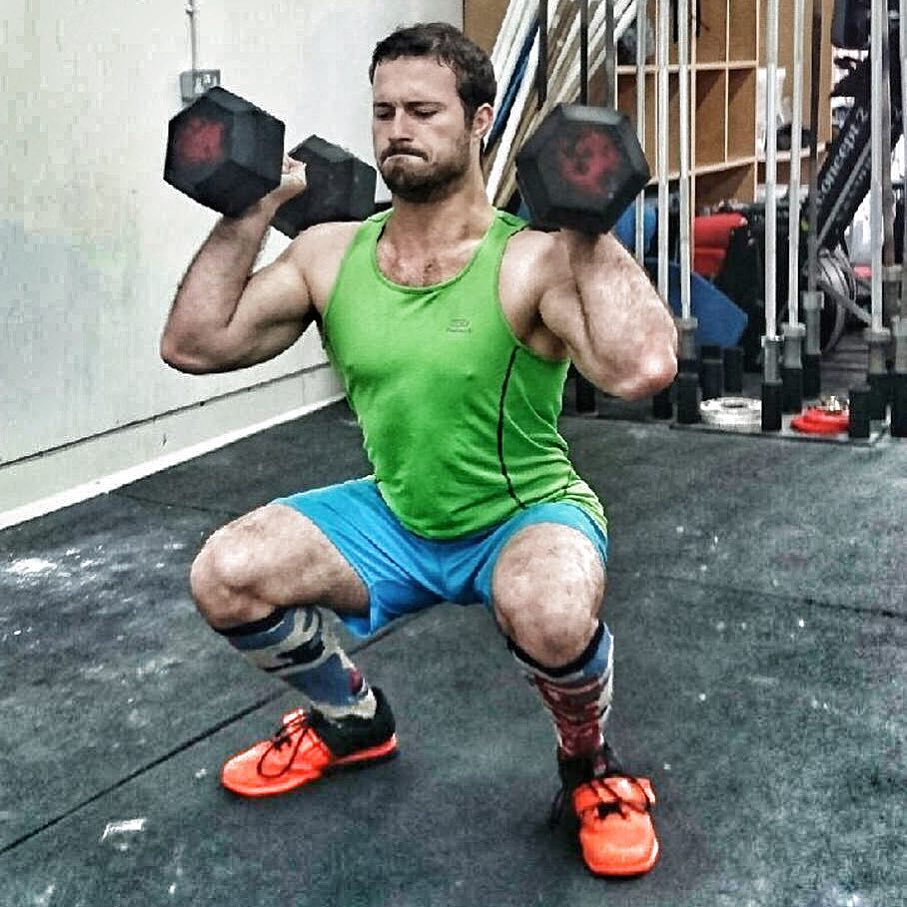
The Dumbbell Front Squat targets your quadriceps muscles in the front of your thighs and your gluteus maximus in the buttocks.
The Dumbbell Front Squat creates on the mechanics of the barbell front squat. Dumbbells may not be fully supported on the torso as they are with barbells, but the goal remains the same: primarily with the elbows pointing forward to support the load on the shoulders. Controlling both dumbbells improves midline stability, control and precise positioning of the body.
Instructions:
- Choose dumbbells of a weight that will enable you to complete the exercise set you choose. Trial and error will enable you to settle on a suitable weight. Start with a light weight.
- Rest the dumbbells on each shoulder with the dumbbells pointing forward.
- Keep the feet as wide as the hips. Keep the ankles firmly planted on the floor and do not let them rise during the exercise.
- Tighten the abdominal muscles. You can identify them by pretending to clear your throat or coughing. You will see the “abs” tightening automatically in the abdominal area.
- Stand tall, shoulders pulled back with good balance.
- Point your butt back as you bend at the knees to begin lowering your body. Make it a well thought out movement. If you focus on that butt backward movement you can get off to a good start with the squat. On descent or when you return to the start position, do not lean back.
- Landing where your thighs are parallel to the floor. As long as you’ve developed good form, less than full distance is fine.
- Press into your heels to straighten your knees and hips and return to standing position. Be sure to keep your chest tall so that the back remains in a neutral position.
2. How To Do Dumbbell Split Squat?
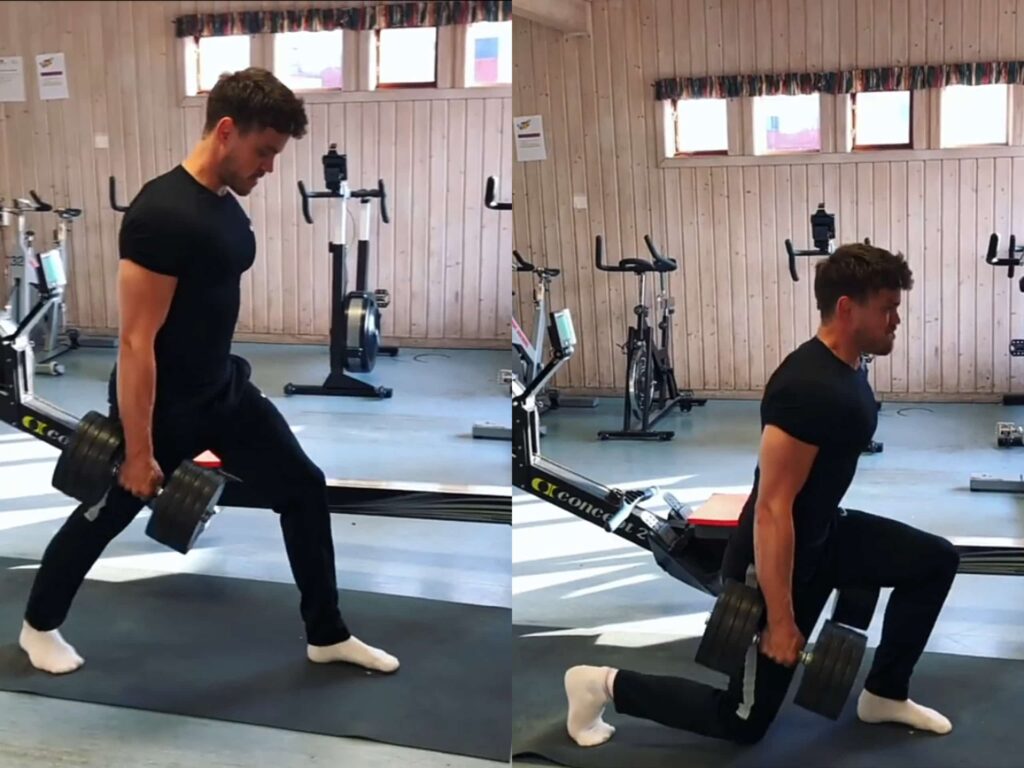
It is hard to argue with anyone who says the best compound leg workouts are the squat and split squat, which works your quads, glutes, and hamstrings in one fell swoop. But that’s not to say that there aren’t highly effective alternatives, and one of them is the dumbbell split squat.
The Dumbbell Split Squat stimulates the same leg muscles as the squat, but the single leg foundation places a significant amount of stress on the abdominal muscles with the added benefit of increasing your overall functional strength.
Instructions:
- From a standing position, take a long step forward as if performing a lunge.
- The heel of your back foot should be raised. Keeping the torso straight, slowly lower until the back knee almost touches the floor, then push back up.
- Complete all the reps on one leg, then switch to your other leg.
- Keep the knees in line with your toes, especially on the front leg, and don’t let your front knee go below your foot.
3. How To Do Barbell Hip Thrust?
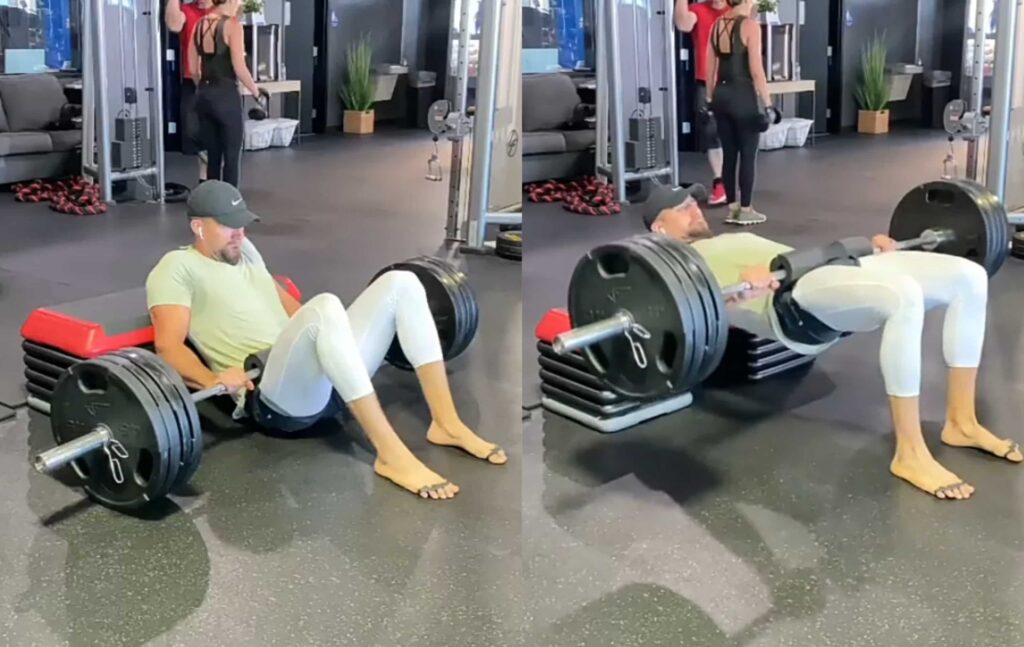
If you want to build size and strength in your derriere, Barbell Hip Thrust should definitely be part of your leg workouts routine. Barbell Hip Thrust is a great glutes builder, this is one exercise you can’t give up.
The Barbell Hip Thrust motion primarily targets the glutes – both the gluteus maximus and gluteus medius – as well as the hamstrings. The quads, core and hip adductors also be work in this.
The workout build strength and size in the glutes in a way many other exercises can’t, and experts agree they offer benefits for many people, from athletes to adults over the age of 65.
Instructions:
- Sit on the ground with a bench behind you, bend your knees so that your feet are on the ground and a barbell under your hips.
- If you have a padded bar, or anything you can slip between the bar and your body, it will go a long way toward making the exercise more comfortable.
- Lean back so that your shoulders are on the bench and place the bar over your hips. Raise your hips while raising the bar.
- In the top position, your knees should be bent at 90 degrees and your shoulders should be near the top of the bench, allowing your body to form a straight line between them. Pause at the top of the lift and squeeze your glutes, then slowly lower your hips.
Also Read: Legs and Butt Exercises















